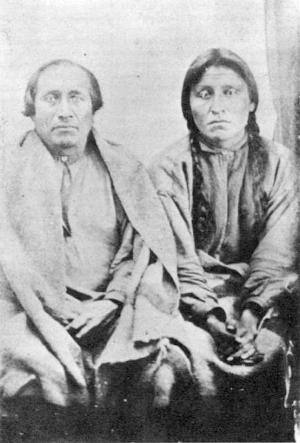 After the war, bounties were offered for Dakota scalps.
After the war, bounties were offered for Dakota scalps.
On July 4, 1863, in response to raids by Dakota in southern Minnesota, the state’s Adjutant-General, Oscar Malmros, issued a general order for the establishment of a mounted corps of “volunteer scouts” to patrol from Sauk Centre to the northern edge of Sibley County. The scouts provided their own arms, equipment, and provisions, were each paid two dollars a day, and were offered an additional $25 for Dakota scalps. A reward of $75 a scalp was offered to people not in military service; that amount was raised to $200 on September 22. Period newspapers described the taking of many scalps.
Taoyateduta (Little Crow)
In September 1862, Little Crow and his small band of followers fled to Canada. In June of 1863, short on food, horses, and provisions, Little Crow and a small party of family and close friends returned to Minnesota.
Late in the afternoon of July 3, 1863, while Little Crow gathered berries in a thicket northwest of Hutchinson with his son Wowinape, Nathan Lamson and his son, Chauncey, saw them and opened fire. The Lamsons were unaware of their victim’s identity until Wowinape, who had fled the scene, was captured by soldiers near Devil's Lake some weeks later. Nathan Lamson later received a $500 check from the State of Minnesota; his son, Chauncey, also collected a bounty.
On July 4, 1863, a group of settlers returned to the site of Little Crow’s death. They scalped the body, then took it to Hutchinson, where an Independence Day celebration was in progress. Debate ensued over whether the body was indeed Little Crow’s; during the debate, it was further mutilated.
The scalp was turned over to the authorities as proof that Indians were still in the area. After the body's identity was confirmed, the scalp was tanned and displayed in the adjutant-general's office. In 1868 it was donated to the Minnesota Historical Society, which had already received Little Crow's skull and some of his bones. The scalp, skull, and bones were exhibited at the Historical Society until 1915. Little Crow's remains were finally interred in 1971 in a family plot near Flandreau, South Dakota.
Contemporary Comment:
"I’ll never forget the day they brought him back. It was this beautiful September day. They brought him back in this little copper box and that was how he was buried. Right at the end of the service, this flock of little blackbirds--this whole flock--came flying up the hill and all around us. I think that was to let us know he was happy with the way things were, to be out of that museum and back here where he belongs."
Billy Gilbert, a descendant of Little Crow, 1993
Medicine Bottle and Sakpe
In January, 1864, Dakota leaders Medicine Bottle and Sakpe (Shakopee) were drugged and kidnapped near the Canadian border. They were brought to Fort Snelling, where they waited to be tried for war crimes. Witnesses called by the U.S. government provided only hearsay evidence; the Dakota men were not allowed to call witnesses on their behalf, nor to cross-examine the government’s witnesses. Sentenced to death, Medicine Bottle and Sakpe were hanged at the fort on November 11, 1865.